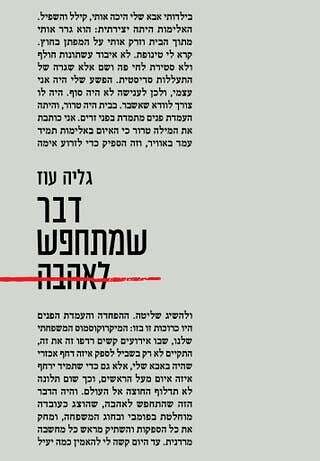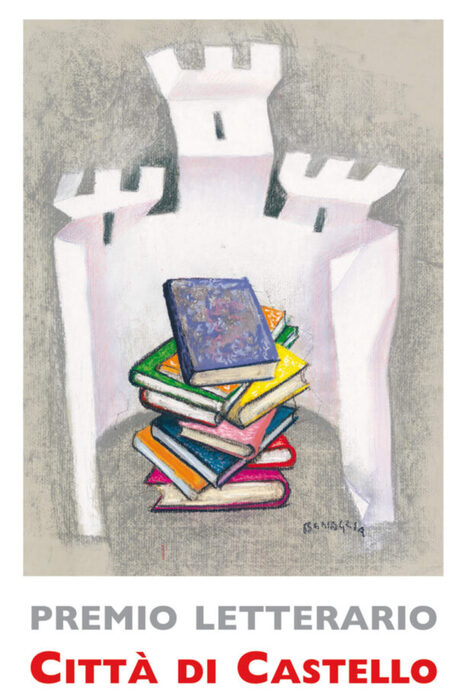Her book is filed as an indictment against her family, and in particular against her father Amos Oz • Despite the seductive glimpse into family life, it has no significant value and her father overshadows her • Book Review
The author does not trust the reader to understand what is hidden under the text.
Galia Oz
Photo:
Melanie Fenton
If a book could be "heard," Galia Oz's book could be described as noisy.
This is not the melancholy and soft whisper of an injured woman, but an aggressive and deafening cry.
As in Edward Monk's painting "The Scream," the writer stands on a metaphorical bridge and cries out in horror her fracture, her pain, and her life.
Oz's book is a kind of late dialogue with her dead father, who since she could not hold it alive, he became a monologue, a daughter's cry towards her father who according to her testimony he did not want to hear, and now can no longer.
The cry of a woman who, she claimed, had suffered abuse from her father for many years, but did not dare to open her mouth and speak.
According to her - her father did not want to listen, her narrow and extended family aspired to maintain the fresh and shiny image of the revered figure of Amos Oz, friends and relatives preferred to turn a blind eye, and some even tried to remain silent over the years.
The descriptions and sentences written by Galia Oz express her outcry, and are hurled almost violently at readers.
First, the cover, which is far from restrained.
From the upper part to the very bottom of the lower part, almost without breathing space, the opening sentences of the book are presented in a dense and small pattern, divided into two, and in the middle - the name of the book and the author and a bright red line that erases the word "love".
There is no consideration for the reader or an attempt to gradually introduce him into the story.
From the first moment, strong, firm, strong sentences are hurled at him.
Like a box in the stomach.
"As a child, my father beat me, cursed and humiliated me," the book opens, with a short, fragmented staccato rhythm.
And also later - writing from which haste, passion and impatience arise.
Oz does not seem to trust the reader - his patience, his understanding of subtext, or his belief in her as a writer.
It does not give the reader an opportunity to be an active partner in her book.
Things are presented to him as facts, without controversy or an opening for interpretations.
The reader does not have to decipher the text, guess or detect.
Everything is served to him on a spoon straight into his mouth.
"My father beat my mother. It happened in my presence" - is an example sentence.
Only later will Oz return to the description of the case.
But right now, on the first page of the book, it is presented concisely as a fact of reality.
Like any illuminator, Oz's book is meant to be therapeutic for the writer as well as for the reader, personal and subjective, bringing only one side of the story, and for Oz this is especially noticeable. It is the main witness and is also used by the plaintiff
. Oz's book belongs to a genre recently known as misery memoirs or misery lit, which tells in the first person about trauma or physical or sexual abuse - usually in childhood by a parent, and overcoming it.
One of the first books in this genre was Angela's Ashes, which was published in 1996, and as with many books in the genre, questions of accuracy and credibility arose when the author's mother, Frank McCourt, denied the narrator.
The genre flourishes in the Mi Tu era, where subjects who were swept under the rug and repressed - come to the surface.
Like any enlightened person, Oz's book is meant to be therapeutic for the writer as well as the reader, very personal and subjective, bringing only one side of the story, and for Oz this is especially noticeable.
She is the main witness in the book and she also serves as the prosecutor and the judge.
In this sense, the book is reminiscent of a legal indictment filed by the plaintiff, who does not want the defendant or anyone on his behalf to challenge his arguments or interpret reality differently.
Oz brings stories and scenes from her life that are not presented as her subjective perception, but as facts.
She uses what she calls "enlightened witnesses" (a character in a child and recognizes the suffering - an expression coined by psychoanalyst Alice Miller; DM) that as witnesses in court - Role reinforce its arguments.
Alongside them, because Oz does not trust the reader to believe her, presents documented evidence That she weaves within her book. Text messages she received from her father's childhood friends and emissaries, a copy of a congratulatory letter to her father's bat mitzvah, etc.
Galia Oz's book is a book of memoirs, The family and especially in her relationship with her father, the writer Amos Oz. The book deals mainly with her early childhood, but also in adulthood. You will not find much personal information about the author: what girl she was, what are her personality lines, her interests. Unusual is the beautiful description of her warm relationship with her grandmother, Jam, but she also talks about her mainly in the context of her father, and in her own language "puts (her) on the witness stand."
We know only a handful of her friends, When the scenes that include them are few and refer only to cases where the family members, and especially her father, were involved.
E to learn about the character of the writer, but indirectly and implicitly, and the result is enlightened that the narrator in it is a flat character that is hard to imagine, and his protagonist is her father.
About him we learn that he was a narcissist, a tyrant, a terrorist, a cruel, not to mention a sadist, and perhaps (so it is implied) a psychopath as well.
And the writer, who is she?
Aside from being very intelligent, and also scared, the reader does not know much about the narrator and her character.
As if even today, and in spite of everything, her being is overshadowed by that of her father.
Amos Oz, the famous writer, experiences a painful abandonment of his mother who committed suicide and testifies to the lack of empathy he experienced towards her in "A Tale of Love and Darkness" (" The days between the rooms of the apartment. There was no drop of pity in me and no longing. I did not mourn the death of my mother ").
His daughter, who is also a writer, herself experienced her father's abandonment and did not show him a degree of pity in "something disguised as love."
In the title of the father and daughter books is the word "love", but the darkness is more present in the daughter's book.
Did this close the cycle of love-abandonment-pain-reckoning, and the intergenerational transmission ended?
Let's hope so.
Something disguised as love / Galia Oz; Kinneret Zmora-Dvir, 107 pages















